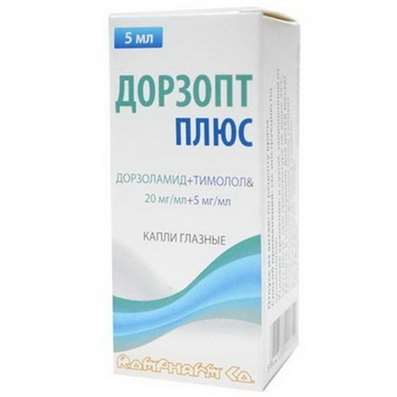Glaumax (Latanoprost) eye drops - is an antiglaucoma drug widely used in ophthalmology where it is used to treat open-angle glaucoma.
Glaumax is an analogue of PgF2alpha, it has anti-glaucoma effect. Reduces intraocular pressure by increasing the outflow of watery moisture through the vascular membrane of the eyeball, does not have a significant effect on the production of aqueous humor and does not affect the hemato-ophthalmic barrier. Can slightly change the size of the pupil. Decrease in intraocular pressure begins 3-4 hours after drug administration, maximum effect after 8-12 hours, the action lasts for at least 24 hours.
Pharmacokinetics
Suction
Latanoprost well penetrates through the cornea, while the hydrolysis of latanoprost to a biologically active form - latanoprost-acid occurs. The maximum concentration of latanoprost in aqueous humor is achieved approximately 2 hours after topical application of the preparation.
Distribution
Latanoprost does not affect the production of watery moisture, but has its effect of reducing intraocular pressure by increasing intraocular outflow. The maximum concentration of latanoprost in aqueous humor is achieved after 2 hours after application. The volume of distribution of latanoprost is 0.16 ± 0.02 l / kg. Latanoprost-acid, detected shortly after application of the drug, is the most significant metabolite of latanoprost and is determined in aqueous humor within the first 4 hours, and in plasma only within 1 hour after topical application. In the tissues of the eye, latanoprost-acid does not undergo any further transformation, but after the transition to the systemic blood flow is actively metabolized.
Metabolism and excretion
Metabolism of latanoprost occurs mainly in the liver. T 1/2 of latanoprost is 17 minutes. The main metabolites - 1,2-dinor- and 1,2,3,4-tetranor metabolites do not possess or have weak biological activity. The final metabolites of latanoprost are excreted mainly by the kidneys: approximately 88% of the administered dose of latanoprost is excreted in the urine.
Indications:
Decreased intraocular pressure in patients:
- With open-angle glaucoma.
- With increased ophthalmotonus.
Contraindications:
- Hypersensitivity to latanoprost, benzalkonium chloride or other components of the drug.
- Age to 18 years.
- Lactation period.
Special instructions:
Glaumax can cause a gradual change in eye color by increasing the amount of brown pigment in the iris. This effect is mainly seen in patients with mixed iris color, for example, blue-brown, gray-brown, green-brown or yellow-brown, which is explained by an increase in melanin in the stromal melanocytes of the iris. Typically, brown pigmentation spreads concentrically around the pupil to the periphery of the iris of the eyes, while the entire iris or parts of it can acquire a more intense brown color. Patients with uniformly colored eyes of blue, gray, green or brown color change eye color after 2 years of use of the drug are very rare. The color change is not accompanied by any clinical symptoms or pathological changes. After the drug was discontinued, there was no further increase in the amount of brown pigment, but the already developed color change may be irreversible. Before starting treatment, patients should be informed about the possibility of changing eye color. In the case of an intense change in eye pigmentation, therapy is discontinued. Treatment of only one eye can lead to permanent heterochromia. In the presence of nevi or lentigo on the iris, their changes were not observed under the influence of therapy.
Perhaps darkening, thickening and lengthening of eyelashes, increasing their density and changing the direction of growth.
The drug contains benzalkonium chloride, which can be absorbed by contact lenses. Before instilling eye drops contact lenses should be removed; to re-install the lens can only be 15-20 minutes after the installation of the drug. It should be borne in mind that against the background of therapy, a brief sensation of "swaddling" in front of the eyes may develop, therefore it is not recommended to drive vehicles or work with moving mechanisms within a few minutes after instillation of the drug.
The bottle must be closed after each use. Do not touch the tip of the pipette to the eye.
Suggested Use:
In the conjunctival sac of the affected eye, one drop is injected 1 time / day, in the evening. When skipping the dose, the next one is administered in the usual mode (i.e., the dose is not doubled).
When prescribing a combination therapy, eye drops of various drugs should be administered at intervals of at least 5 minutes.
With caution, Glaumax is recommended for patients with aphakia, pseudoafacies, damage to the posterior capsule of the lens and known risk factors for macular edema (in the treatment with latanoprost, cases of development of macular edema, including cystoid) are described.
Currently, there are no data on the use of Glaumax in inflammatory eye diseases, inflammatory, neovascular, occlusive and congenital glaucoma. There is little experience with the use of the drug in open-angle glaucoma in patients with artifacty, as well as in pigmentary glaucoma. Glaumax has no or little effect on the pupil, but there is no evidence of the effect of the drug in an acute attack with closed-angle glaucoma. With these conditions, Glaumax is recommended with caution.
Packaging:
- Comes in original packaging. Item is brand new and unopened.
Storage:
- Keep away from direct sunlight.
- Keep locked and away from children.
- Store in dry place at room temperature.
- Do not exceed storage temperature higher than 25 C
Important notice- the outer box design may vary before prior notice!

 Cart
Cart





